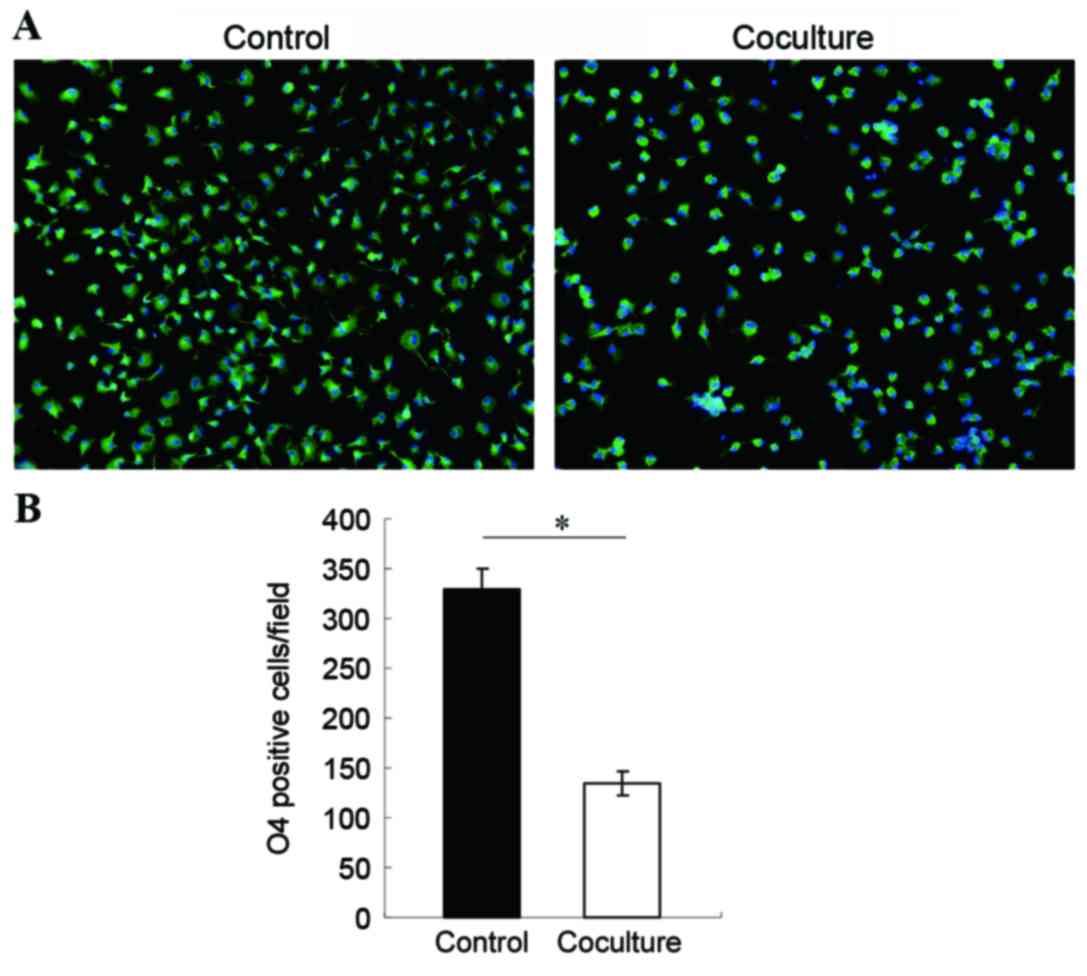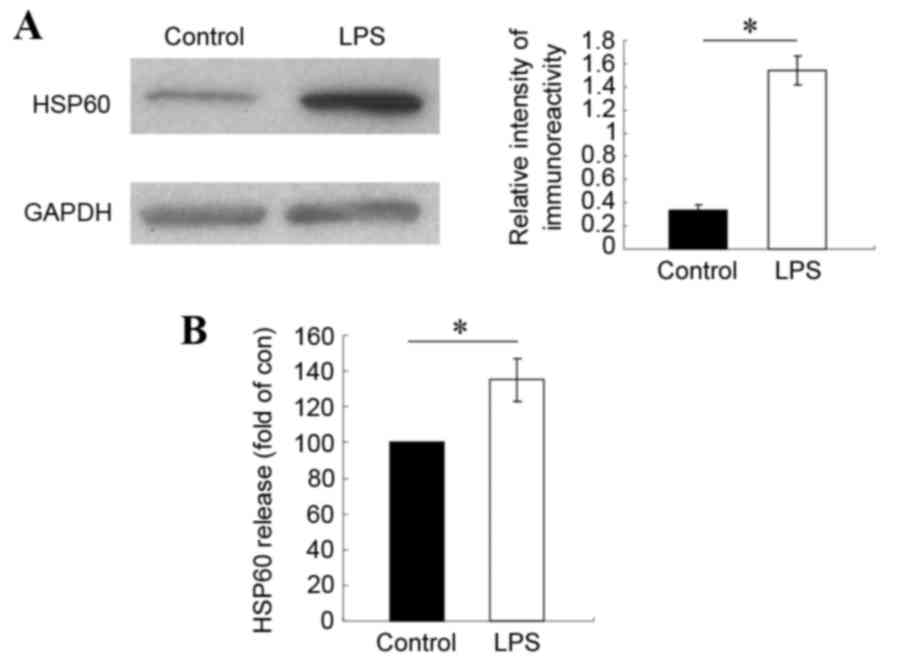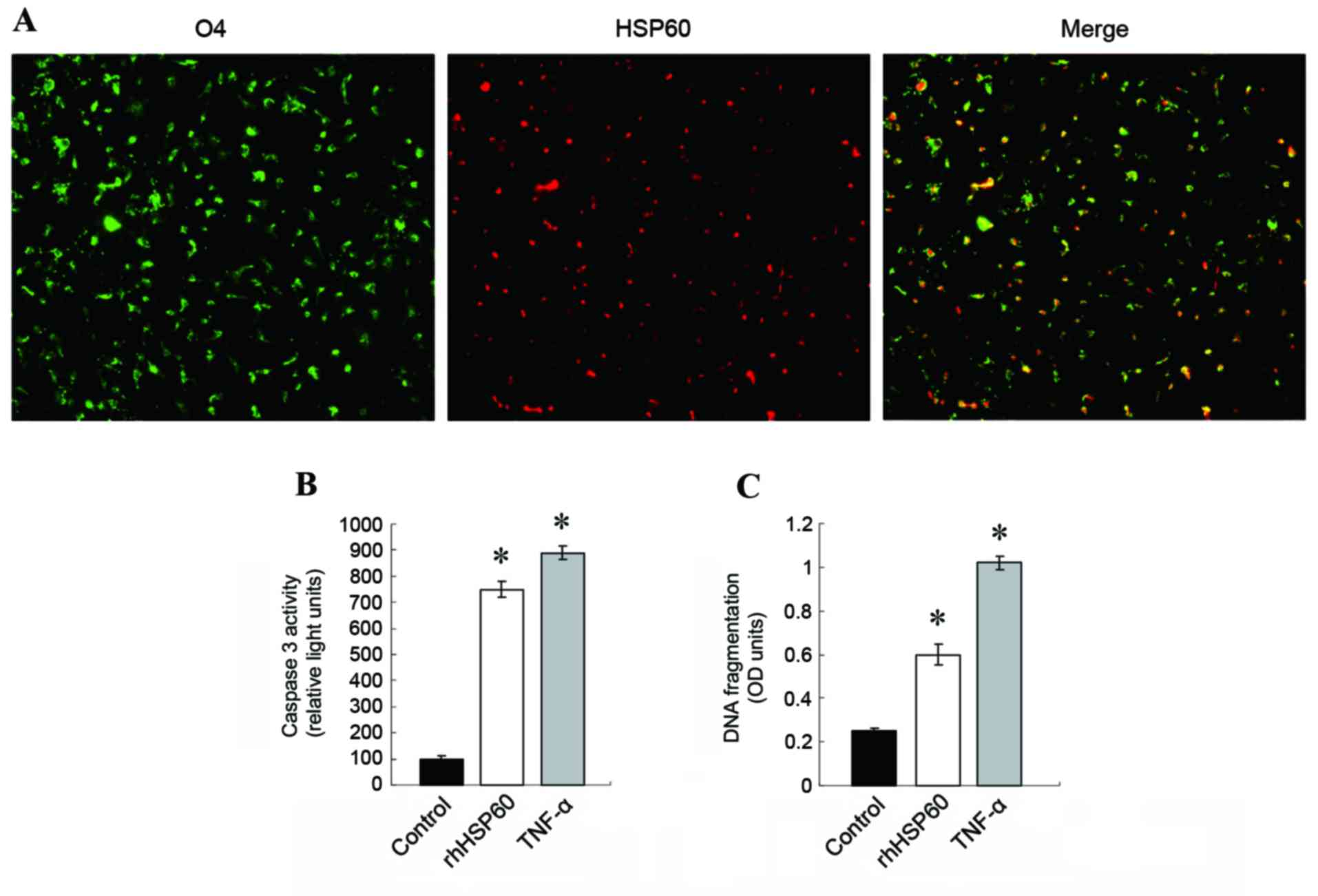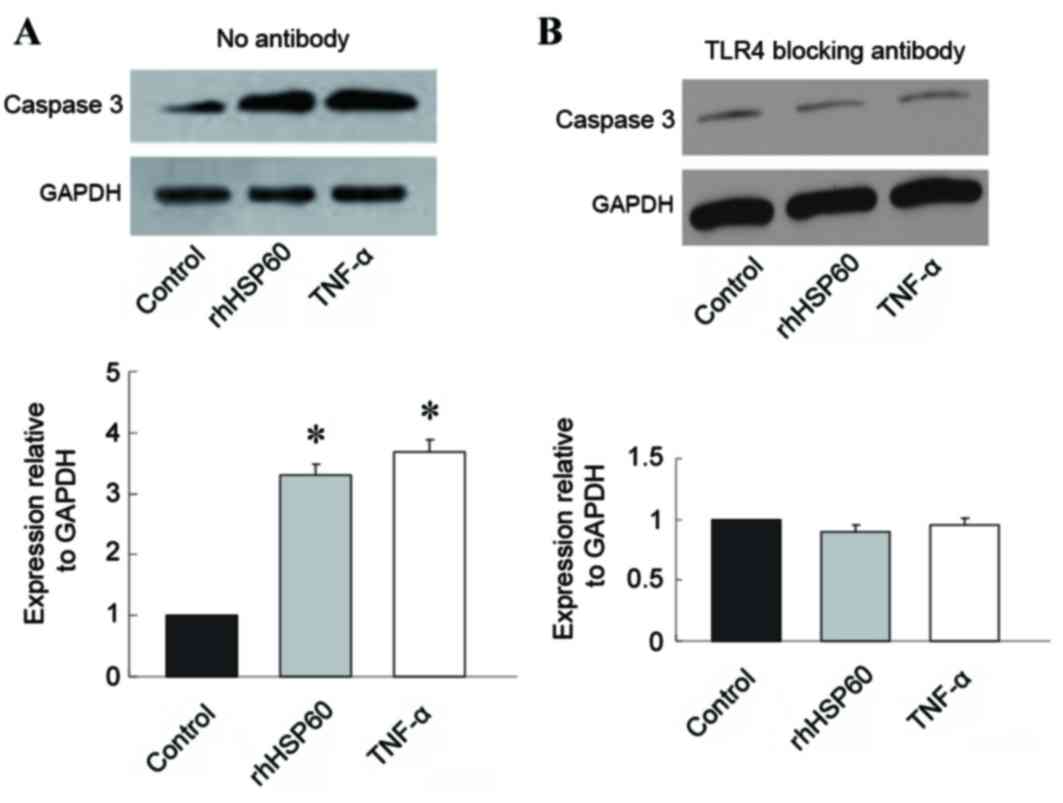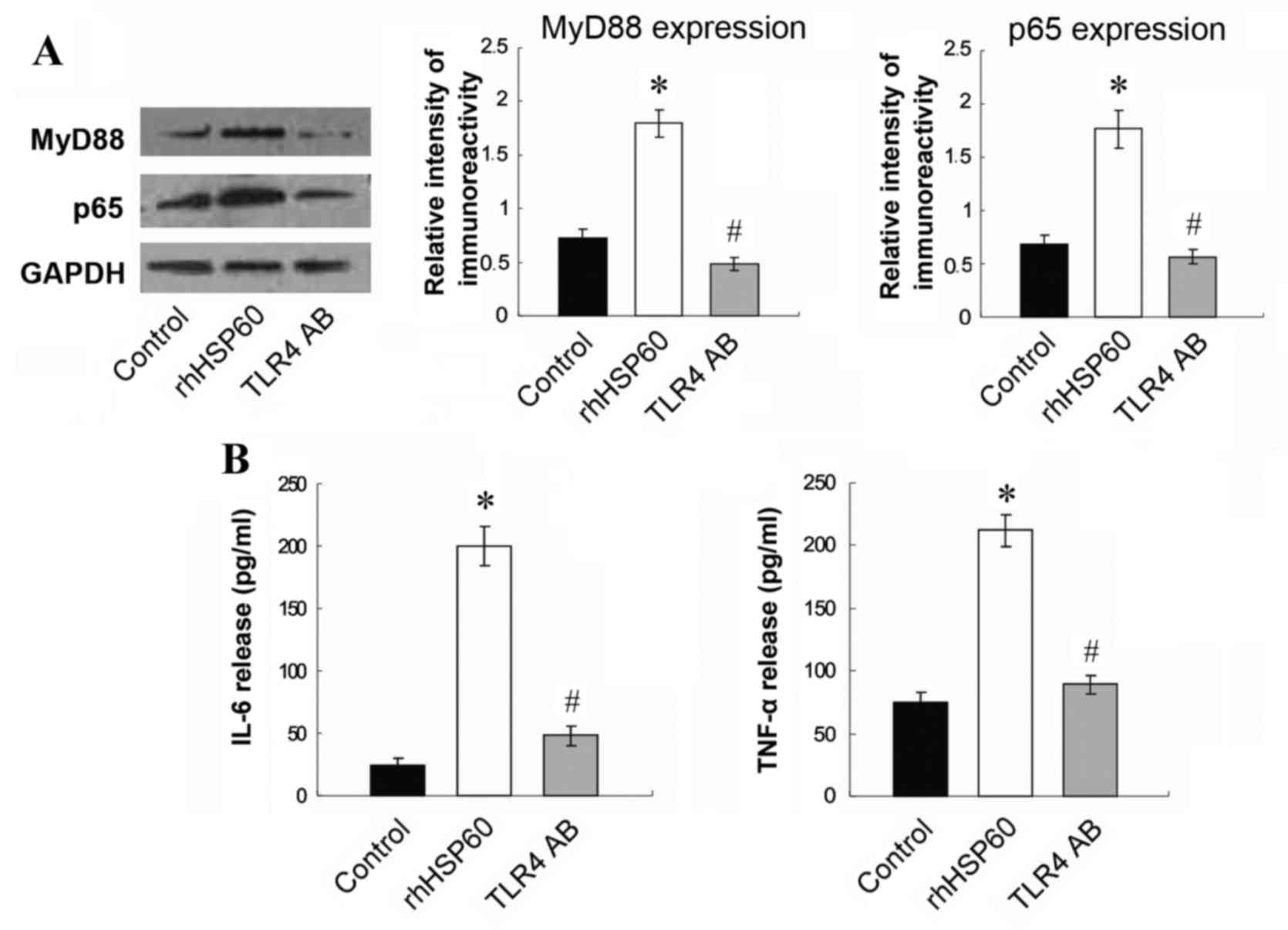|
1
|
Hanisch UK and Kettenmann H: Microglia:
Active sensor and versatile effector cells in the normal and
pathologic brain. Nat Neurosci. 10:1387–1394. 2007. View Article : Google Scholar : PubMed/NCBI
|
|
2
|
McGuire SO, Ling ZD, Lipton JW, Sortwell
CE, Collier TJ and Carvey PM: Tumor necrosis factor alpha is toxic
to embryonic mesencephalic dopamine neurons. Exp Neurol.
169:219–230. 2001. View Article : Google Scholar : PubMed/NCBI
|
|
3
|
Chao CC, Hu S, Ehrlich L and Peterson PK:
Interleukin-1 and tumor necrosis factor-alpha synergistically
mediate neurotoxicity: Involvement of nitric oxide and of
N-methyl-D-aspartate receptors. Brain Behav Immun. 9:355–365. 1995.
View Article : Google Scholar : PubMed/NCBI
|
|
4
|
Pfeiffer SE, Warrington AE and Bansal R:
The oligodendrocyte and its many cellular processes. Trends Cell
Biol. 3:191–197. 1993. View Article : Google Scholar : PubMed/NCBI
|
|
5
|
Block ML, Zecca L and Hong JS:
Microglia-mediated neurotoxicity: Uncovering the molecular
mechanisms. Nat Rev Neurosci. 8:57–69. 2007. View Article : Google Scholar : PubMed/NCBI
|
|
6
|
Kim SC, Stice JP, Chen L, Jung JS, Gupta
S, Wang Y, Baumgarten G, Trial J and Knowlton AA: Extracellular
heat shock protein 60, cardiac myocytes, and apoptosis. Circ Res.
105:1186–1195. 2009. View Article : Google Scholar : PubMed/NCBI
|
|
7
|
Gupta S and Knowlton AA: HSP60, Bax,
apoptosis and the heart. J Cell Mol Med. 9:51–58. 2005. View Article : Google Scholar : PubMed/NCBI
|
|
8
|
Tian J, Guo X, Liu XM, Liu L, Weng QF,
Dong SJ, Knowlton AA, Yuan WJ and Lin L: Extracellular HSP60
induces inflammation through activating and up-regulating TLRs in
cardiomyocytes. Cardiovasc Res. 98:391–401. 2013. View Article : Google Scholar : PubMed/NCBI
|
|
9
|
Knowlton AA and Gupta S: HSP60, Bax, and
cardiac apoptosis. Cardiovasc Toxicol. 3:263–268. 2003. View Article : Google Scholar : PubMed/NCBI
|
|
10
|
Kirchhoff SR, Gupta S and Knowlton AA:
Cytosolic heat shock protein 60, apoptosis, and myocardial injury.
Circulation. 105:2899–2904. 2002. View Article : Google Scholar : PubMed/NCBI
|
|
11
|
Wang Y, Chen L, Hagiwara N and Knowlton
AA: Regulation of heat shock protein 60 and 72 expression in the
failing heart. J Mol Cell Cardiol. 48:360–366. 2010. View Article : Google Scholar : PubMed/NCBI
|
|
12
|
Lin L, Kim SC, Wang Y, Gupta S, Davis B,
Simon SI, Torre-Amione G and Knowlton AA: HSP60 in heart failure:
Abnormal distribution and role in cardiac myocyte apoptosis. Am J
Physiol Heart Circ Physiol. 293:H2238–H2247. 2007. View Article : Google Scholar : PubMed/NCBI
|
|
13
|
Teng P, Li Y, Cheng W, Zhou L, Shen Y and
Wang Y: Neuroprotective effects of Lycium barbarum polysaccharides
in lipopolysaccharide-induced BV2 microglia cells. Mol Med Rep.
7:1977–1981. 2013.PubMed/NCBI
|
|
14
|
Cheng W, Hou X, Zhang N, Ma J, Ding F, Li
F, Miao Z, Zhang Y, Qi Q, Li G, et al: HSP60 is involved in the
neuroprotective effects of naloxone. Mol Med Rep. 10:2172–2176.
2014.PubMed/NCBI
|
|
15
|
Cheng W, Li Y, Hou X, Bai B, Li F, Ding F,
Ma J, Zhang N, Shen Y and Wang Y: Determining the neuroprotective
effects of dextromethorphan in lipopolysaccharide-stimulated BV2
microglia. Mol Med Rep. 11:1132–1138. 2015.PubMed/NCBI
|
|
16
|
Ohashi K, Burkart V, Flohé S and Kolb H:
Cutting edge: Heat shock protein 60 is a putative endogenous ligand
of the toll-like receptor-4 complex. J Immunol. 164:558–561. 2000.
View Article : Google Scholar : PubMed/NCBI
|
|
17
|
Taylor DL, Pirianov G, Holland S,
McGinnity CJ, Norman AL, Reali C, Diemel LT, Gveric D, Yeung D and
Mehmet H: Attenuation of proliferation in oligodendrocyte precursor
cells by activated microglia. J Neurosci Res. 88:1632–1644.
2010.PubMed/NCBI
|
|
18
|
Lehnardt S, Lachance C, Patrizi S,
Lefebvre S, Follett PL, Jensen FE, Rosenberg PA, Volpe JJ and
Vartanian T: The toll-like receptor TLR4 is necessary for
lipopolysaccharide-induced oligodendrocyte injury in the CNS. J
Neurosci. 22:2478–2486. 2002.PubMed/NCBI
|
|
19
|
Yang Z, Watanabe M and Nishiyama A:
Optimization of oligodendrocyte progenitor cell culture method for
enhanced survival. J Neurosci Methods. 149:50–56. 2005. View Article : Google Scholar : PubMed/NCBI
|
|
20
|
Rosenberger K, Dembny P, Derkow K, Engel
O, Krüger C, Wolf SA, Kettenmann H, Schott E, Meisel A and Lehnardt
S: Intrathecal heat shock protein 60 mediates neurodegeneration and
demyelination in the CNS through a TLR4- and MyD88-dependent
pathway. Mol Neurodegener. 10:52015. View Article : Google Scholar : PubMed/NCBI
|
|
21
|
Chao CC, Hu S, Molitor TW, Shaskan EG and
Peterson PK: Activated microglia mediate neuronal cell injury via a
nitric oxide mechanism. J Immunol. 149:2736–2741. 1992.PubMed/NCBI
|
|
22
|
Filipović R and Zecević N: 2005.
Interaction between microglia and oligodendrocyte cell progenitors
involves Golli proteins. Ann N Y Acad Sci. 1048:166–174. 2005.
View Article : Google Scholar : PubMed/NCBI
|
|
23
|
Miller BA, Crum JM, Tovar CA, Ferguson AR,
Bresnahan JC and Beattie MS: Developmental stage of
oligodendrocytes determines their response to activated microglia
in vitro. J Neuroinflamm. 4:282007. View Article : Google Scholar
|
|
24
|
Pang Y, Cai Z and Rhodes PG: Effects of
lipopolysaccharide on oligodendrocyte progenitor cells are mediated
by astrocytes and microglia. J Neurosci Res. 62:510–520. 2000.
View Article : Google Scholar : PubMed/NCBI
|
|
25
|
Liu X, Fan XL, Zhao Y, Luo GR, Li XP, Li R
and Le WD: Estrogen provides neuroprotection against activated
microglia-induced dopaminergic neuronal injury through both
estrogen receptor-alpha and estrogen receptor-beta in microglia. J
Neurosci Res. 81:653–665. 2005. View Article : Google Scholar : PubMed/NCBI
|
|
26
|
Butovsky O, Landa G, Kunis G, Ziv Y,
Avidan H, Greenberg N, Schwartz A, Smirnov I, Pollack A, Jung S and
Schwartz M: Induction and blockage of oligodendrogenesis by
differently activated microglia in an animal model of multiple
sclerosis. J Clin Invest. 116:905–915. 2006. View Article : Google Scholar : PubMed/NCBI
|
|
27
|
Khasnavis S, Jana A, Roy A, Mazumder M,
Bhushan B, Wood T, Ghosh S, Watson R and Pahan K: Suppression of
nuclear factor-κB activation and inflammation in microglia by
physically modified saline. J Biol Chem. 287:29529–29542. 2012.
View Article : Google Scholar : PubMed/NCBI
|



